Abstract
Navigating the intertwined challenges of digital transformation, sustainability, education, and social inclusion is crucial for equitable global progress. This study contributes to this challenge by presenting an integrative model based on a systematic review of the scientific literature exploring their intersection. Following the Consolidated Meta-Analytical Approach Theory (TEMAC) methodology, core studies from the Scopus and Web of Science databases were systematically selected using strict inclusion criteria and Kappa index reliability testing. The review identified five key research fronts: digital inequality, inclusive education, public policies and infrastructure, digital accessibility, and sustainable educational models. These findings collectively reveal how improving digital access, fostering inclusive governance, and ensuring equitable education emerge as interconnected drivers of sustainable development. In this regard, the proposed model aligns with the broader objectives of the United Nations Sustainable Development Goals, offering a multidimensional framework to guide future research and inform the development of effective public policies for sustainable digital education.
1. Introduction
The profound digital transformation witnessed in recent decades, its pace intensified by the pandemic, is fundamentally altering social, economic, and educational structures. This transformation also reveals persistent inequalities in access, use, and appropriation of digital technologies, especially in socially vulnerable contexts [1]. The benefits of this digital revolution remain unequally distributed. The world is undergoing a rapid digital transformation, driven by the widespread adoption of the Internet and the emergence of new technologies like Generative AI, which are quickly reshaping work and productivity [2]. Despite this advancement, it also poses significant threats such as increased inequality. Historically, job automation has negatively impacted wages for affected workers [3]. Today, a primary concern is that Generative AI’s benefits are primarily focused on the upper–middle class [2], which presents a significant problem, especially in developing countries. Many workers who could benefit from GenAI lack access to the necessary digital tools in their current jobs. For instance, in Latin America, nearly half of the workforce might miss out on Generative AI’s productivity boosts due to this limited access, preventing them from reaching their full potential. In Brazil, specifically, only 40% of poor workers who could benefit from Generative AI actually have the digital access required at work [4]. This digital access gap disproportionately burdens low-income workers through lost productivity. Without targeted interventions, the digital revolution risks worsening existing inequalities instead of fostering inclusive growth, thereby complicating global efforts towards digital and sustainable education and social inclusion (see Figure A1). Within this context, education plays a key role in digital and social inclusion, helping mitigate the digital divide’s effects [5]. Literature shows that digital exclusion reflects and amplifies existing social inequalities related to gender, income, age, and location. These barriers limit the full participation of marginalized groups in the digital society [6].
As the authors of [7] define it, digital transformation in education involves a fundamental rethinking of how individuals, data, and processes converge to cultivate enhanced environments for students, educators, parents, and system leaders within the contemporary digital landscape, while simultaneously anticipating future innovations and challenges. Despite the opportunities brought about by digital innovation, structural barriers still limit equitable access to digital technologies, directly impacting the goals of educational inclusion [8]. The urgent need for this transformation was acutely highlighted by the COVID-19 pandemic, which exposed systemic unpreparedness for remote learning and exacerbated existing equity gaps in technological access [7]. For instance, digital transformation in higher education institutions (HEIs) has been associated with new forms of sustainable management, personalized learning, and the inclusion of historically marginalized groups [9]. As of 2025, the education sector continues to grapple with persistent challenges in improving learning outcomes, meeting the evolving demands for future-ready skills, and bridging educational disparities (e.g., [10,11]).
Educational sustainability, in this context, refers to educational practices that empower students and educators to act responsibly and collaborate in creating a sustainable learning environment, ultimately informing and positively influencing society on both local and global scales [12]. Inclusive education models, mediated by information and communication technologies (ICT), have demonstrated promising outcomes. Educational innovation experiences using transmedia storytelling, for example, have enhanced the social inclusion of older adults by fostering digital skills and promoting social awareness among university students [13]. Such initiatives highlight the relevance of technological mediation in developing sustainability competencies while broadening access to and active participation in education [14]. In this regard, promoting inclusive digital citizenship requires robust public policies, technological infrastructure, teacher training, and coordinated efforts among governments, educational institutions, and civil society [15].
The interaction between digital inequality and other research fronts—such as teacher training, institutional infrastructure, and public policy remains underexplored. The findings of this review suggest that these dimensions are deeply interconnected, influencing both the effectiveness of inclusive education and the success of sustainable digital transformation. Further studies should adopt integrated approaches to better understand how these factors mutually reinforce digital inclusion or exclusion.
The United Nations 2030 Agenda [16], through the Sustainable Development Goals (SDGs), acknowledges the centrality of digital inclusion and quality education as pillars for fostering more just and sustainable societies [17]. Despite growing interest in the intersection of education, sustainability, and digital transformation [9,18,19,20,21,22,23,24], few efforts have succeeded in integrating these dimensions into a unified, global, and multidisciplinary perspective [20,25]. A significant gap remains in the availability of strategic frameworks that can adequately address the complexity of this intersection. Much of the existing research tends to focus narrowly on technology implementation, paying insufficient attention to long-term impacts, social inclusion, and sustainability. This fragmented approach hinders the development of coordinated strategies necessary to advance equitable and sustainable digital education at scale.
Understanding the main contributions in this domain is essential for consolidating knowledge into a conceptual model capable of guiding future frameworks and research. Improving the long-term sustainability of emerging technologies is essential, as it ensures that their implementation benefits both the environment and social well-being. The importance of social sustainability lies in equitably distributing the benefits of digital transformation, fostering inclusivity, and minimizing negative impacts on ecosystems and communities. Considering this rapidly evolving landscape, particularly concerning digital and sustainable education and social inclusion, it is important for academia to focus on this phenomenon. This study addresses this requirement by proposing an integrated model that is based on the existing literature and serves as a foundational framework for further exploration in this crucial research area. This model offers a novel and timely contribution by synthesizing disparate concepts into a cohesive structure, thereby facilitating a more comprehensive and systematic understanding of the complex interplay between digital transformation, sustainability, and social inclusion within educational contexts. Therefore, this study aims to answer the following research questions:
- (a)
- What are the main contributions of the scientific literature regarding education’s role in promoting social inclusion and sustainable digital transformation?
- (b)
- Who are the leading authors in this field?
- (c)
- What are the main research fronts?
- (d)
- How is the scientific literature structured around this topic?
This review is justified by the need to critically map the scientific production that connects digital, sustainable, inclusive, and educational dimensions, providing theoretical and practical support for researchers, educators, and policymakers. As shown by the authors of [9], there has been exponential growth in scientific publications on digital transformation and sustainability in education between 2015 and 2019, reinforcing the timeliness of an integrative literature analysis. Beyond expanding access to knowledge, digital inclusion in the educational field plays a strategic role in promoting both environmental and economic sustainability. The digitization of educational materials and the use of virtual learning environments significantly reduce paper consumption, physical transportation, and traditional school infrastructure, thus contributing to the mitigation of environmental impacts [9,15]. Additionally, integrating digital technologies into educational processes fosters positive economic externalities by enabling greater scalability of educational resources, optimizing teachers’ time, and lowering operational costs for educational institutions [14,26]. When aligned with the SDGs, particularly SDGs 4, 9, and 12, these practices demonstrate how educational digital transformation can be inclusive, regenerative, and economically efficient [1,17].
Accordingly, the main objective of this research is to present an integrative model based on a systematic literature review that analyzes how education can promote sustainable digital transformation and social inclusion. By integrating education, social inclusion, and digitalization, this study aims to outline a sustainable development model capable of reducing structural inequalities (SDG 10), strengthening educational institutions (SDG 4), and fostering more resilient and intelligent cities (SDG 11). Therefore, this study reinforces that sustainable digital transformation requires more than adopting technologies. It demands ethical, inclusive, and environmentally responsible practices in their implementation.
The perspective adopted in this systematic review considers that sustainability extends beyond the ecological dimension, encompassing social justice, digital equity, and universal access to knowledge as fundamental public goods. Accordingly, the structure of this manuscript departs from traditional formats: the findings emerge directly from the literature and constitute the central contribution of the study. Therefore, the manuscript is organized into the following sections: Materials and Methods, Results, Proposed Integrative Model, Discussion, and Conclusion.
2. Materials and Methods
This study employed an exploratory approach based on the Theory of the Consolidated Meta-Analytical Perspective (TEMAC), developed by the authors of [27]. The Consolidated Meta-Analytical Focus Theory (TEMAC) emerges as a robust and accessible methodological alternative to traditional literature review approaches, particularly addressing the limitations of pure meta-analysis. In fields such as management, the application of meta-analytical techniques is often constrained by methodological heterogeneity, the lack of standardized primary data, and the requirement for comparable quantitative studies [27]. The TEMAC overcomes these challenges by integrating the strengths of qualitative, integrative, systematic, and meta-analytical reviews. It operates across multiple databases and is grounded in established bibliometric principles and laws—, including Bradford’s Law, Lotka’s Law, the Elitism Principle, Zipf’s Law, and Goffman’s Epidemic Theory, to ensure methodological precision, validity, and robustness [27].
In this context, the present study adopts the Theoretical Consolidated Meta-Analytical Approach (TEMAC), which goes beyond data integration platforms such as SciVal, InCites, or Dimensions. While these platforms are primarily focused on institutional quantitative analyses and performance indicators, the TEMAC enables researchers to conduct an in-depth thematic and conceptual analysis grounded in clearly defined methodological criteria. This approach supports the development of integrative theoretical models and the identification of gaps and convergences within the literature, providing a more qualified and strategic understanding of the field under investigation. Furthermore, the TEMAC is designed to optimize functionality while minimizing the researcher’s workload. Its structured and replicable three-step process leverages only free and widely accessible software tools—such as Publish or Perish, VOSviewer, Excel, and TagCrowd—making it especially suitable for researchers with limited technical or financial resources. This approach aligns with the usability criteria proposed by the authors of [28], particularly in terms of performance expectations, effort efficiency, and facilitating conditions. By incorporating multi-database analysis, combining bibliometric and content analysis techniques, and supporting expert validation, the TEMAC significantly enhances the analytical and strategic potential of literature reviews in management research. It is especially useful for identifying theoretical gaps, mapping research trends, and developing integrative models based on empirical evidence [27].
The TEMAC framework is structured in three stages:
- Research Preparation.
- Data Presentation and Interrelation.
- Detailing, Integrative Modeling, and Evidence-Based Validation.
All three stages of the TEMAC follow the PRISMA protocol—Preferred Reporting Items for Systematic Reviews and Meta-Analyses.
2.1. Database Selection and Literature Search
Two internationally recognized databases were selected for the construction of this study’s document corpus: Web of Science (WoS) and Scopus. The selection was based on methodological criteria aligned with the TEMAC model (Theory of the Consolidated Meta-Analytical Focus), which recommends the use of multiple databases to enhance the robustness and validity of the analysis [27]. Both platforms offer broad multidisciplinary coverage, high-quality metadata, and rigorous peer-review indexing processes, with them being widely acknowledged by universities and research funding agencies worldwide.
The search strategy followed the guidelines of the TEMAC’s first stage—research preparation—which involves defining descriptors, temporal boundaries, and knowledge domains. The search string applied was: Digital AND Sustainable AND Education AND “Social Inclusion”, structured using Boolean operators and quotation marks to maximize search precision. The term “Social Inclusion” was enclosed in quotation marks to ensure the retrieval of records in which this concept was contextually explicit. This combination of descriptors allowed for the inclusion of publications addressing the intersection of digital transformation, sustainability, educational processes, and social inclusion—four core pillars for the development of academic practices and public policies aligned with the UN 2030 Agenda [16].
2.2. Selection Criteria
Although the total number of retrieved documents was not particularly high when compared to broader searches, the results were considered qualitatively significant, as they encompassed a wide range of scientific publications, including journal articles, conference proceedings, and technical reports. This diversity reflects the multidisciplinary and transversal nature of the topic, as emphasized by the TEMAC model, which promotes integration across different methodological approaches and fields of knowledge [27].
Explicit inclusion and exclusion criteria were applied based on a careful reading of titles and abstracts, in accordance with the TEMAC’s second stage—data presentation and interrelation. The inclusion criteria adopted were as follows: (i) full-text availability; (ii) peer-reviewed publications; and (iii) articles written in English, to ensure scientific quality, methodological rigor, and international comparability. In turn, the exclusion criteria involved removing documents whose content was not aligned with the central objectives of the study or that addressed the thematic axes in a superficial or tangential manner.
This selection process aimed to eliminate semantic noise and reinforce the thematic coherence of the final sample, ensuring that the selected records meaningfully contributed to the identification of research trends, theoretical approaches, and gaps in the literature on the intersection between digitalization, sustainability, education, and social inclusion. As emphasized by [27], this initial filtering step is essential to ensure the consistency of subsequent analytical stages, such as bibliometric mapping, co-authorship and keyword co-occurrence networks, and the formulation of integrative models.
2.3. Selection and Extraction Process
The flow diagram of PRISMA (Preferred Reporting Items for Systematic Reviews and Meta-Analyses) illustrates the systematic review process, guided by the stages of the Theory of the Consolidated Meta-Analytical Perspective (TEMAC) (Figure 1).
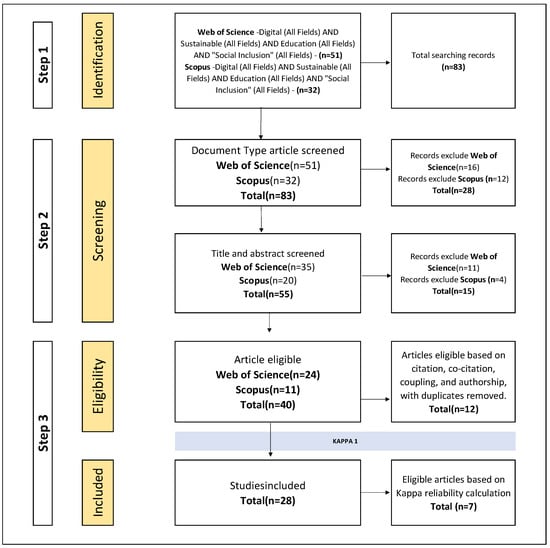
Figure 1.
PRISMA protocol.
The first PRISMA phase, Identification, corresponds to Step 1 of the TEMAC (Research Preparation), which involves the initial mapping and retrieval of scientific output. At this stage, 83 records were identified across the WoS (n = 51) and Scopus (n = 32) databases, aiming to capture the full range of publications related to the research theme using a structured Boolean search strategy.
Subsequently, during the Screening phase, filters were applied to include only scientific journal articles. A total of 28 records were excluded (16 from WoS and 12 from Scopus), leaving 55 documents. These were then screened by title and abstract, resulting in an additional 15 articles being excluded due to lack of thematic relevance, leading to a final selection of 40 eligible articles (24 from WoS and 11 from Scopus). This stage corresponds to Step 2 of the TEMAC framework (Data Presentation and Interrelation). The third PRISMA phase, Eligibility, involved a connectivity analysis based on citation, co-citation, bibliographic coupling, and co-authorship. Twelve articles were removed at this stage, leaving 28 considered central to theoretical construction, forming a core body of literature. Finally, an inter-rater reliability test (Kappa index) was applied in the Included phase to ensure agreement among reviewers and validate the inclusion of the 28 articles selected to develop the final integrative model. This stage is crucial for ensuring methodological rigor and scientific validation, allowing for the construction of a robust integrative model based on the analyzed evidence. The last two phases are aligned with Step 3 of the TEMAC framework (Detailing, Integrative Modeling, and Evidence-Based Validation), demonstrating the adaptability of the TEMAC to the PRISMA protocol.
2.4. Analysis and Synthesis of Results
In this study, the TEMAC was applied. We adopted this approach due to its increasing adoption in the academic community, driven by its ease of replication, use of free and open-access software, low learning curve, and a favorable balance between required effort and perceived benefits. This study applies the PRISMA protocol within the TEMAC methodology to explore how education drives social inclusion and contributes to reducing the digital divide, connecting the themes of sustainability, digital transformation, and inclusion. To this end, key contributions from the literature were identified and analyzed through co-citation and bibliographic coupling maps using VOSviewer software (version 1.6.18), revealing the main conceptual approaches and research fronts. Based on these results, a detailed reading of the selected articles was conducted to develop an integrative model. The following parameters were applied: a minimum of four citations for keyword co-occurrence, two for co-citation analysis, and zero for coupling, all limited to the past three years. Density visualizations were generated using the rainbow color scheme configuration for both co-citation and coupling maps.
3. Results
In this section, we will present the findings of our systematic review, describing the search methodology and insights obtained from the analyzed literature.
3.1. Step 1—Research Preparation
The keywords used were Digital, Sustainable, Education, and “Social Inclusion”. These terms were selected to explore the state of the art concerning the intersection of these topics. The search string was constructed as shown in Table 1.

Table 1.
Search strategy in WoS and Scopus databases.
The initial search returned a total of 83 documents across both databases combined. In the second stage, after applying a filter for document type (journal articles), the number was reduced to 55 records. Finally, based on the review of titles and abstracts, 30 articles were selected for their strong alignment with the research topic. Five duplicate articles were identified across both databases; however, the results were treated separately.
All articles were retained in each database to analyze their distribution across indexing platforms and to compare the presence and visibility of publications in a European database (Scopus) and an American database (WoS).
3.2. Step 2—Data Presentation and Interrelation
From the search conducted across both databases, we found that the earliest record in the WoS database was the article “The Library of Birmingham Project: Lifelong Learning for the Digital Age” by Blewitt and Gambles (2010) [21]. In this work, the authors explain that although libraries remain open and accessible centers of knowledge, their engagement with the working class remains limited, thus requiring a reconceptualization of their role. The authors outline various actions and challenges through the Birmingham Library Project, highlighting how a public library can become an active agent of change. This renewed role envisions libraries as contributors to social capital within communities, promoting digital inclusion and literacy through librarians’ Internet access and serving as hubs for contemporary topics such as entrepreneurship and innovation, all developed in collaboration with the local population. In this way, through partnerships among public entities, private actors, and the third sector, Birmingham stimulated sustainable growth by transforming libraries into community spaces that welcome ethnically diverse populations—among the most diverse in Europe.
In the Scopus database, the earliest record was “Retos para la integración de las personas inmigrantes en las Smart Cities: el caso de Madrid” by Oteyza, Sosa, and Lara (2020) [29] This study highlights the necessity of transforming Madrid into a smart city by promoting justice and equity by including its citizens (particularly migrants), who are considered vulnerable. To achieve this integration, the authors emphasize the importance of leveraging available knowledge and information technologies to create transnational spaces that connect countries of origin and destination. However, for this process to succeed, the digital divide must be closed, ensuring access for individuals of all ages.
Digitalization is identified as a key enabler of smarter cities across both previous contexts; however, it also presents challenges, such as the need to ensure digital inclusion for diverse populations, including immigrants and the elderly. Both studies emphasize the vital role of public–private partnerships and third-sector involvement, particularly in reimagining public spaces—such as libraries—as hubs to bridge the digital divide.
An analysis of keyword co-occurrence in WoS (Figure 2) reveals that terms such as “lifelong learning” and “access” appeared frequently between 2016 and 2018. This reflects a growing concern with lifelong digital learning and equitable access to digital resources as key components for achieving more sustainable urban environments.
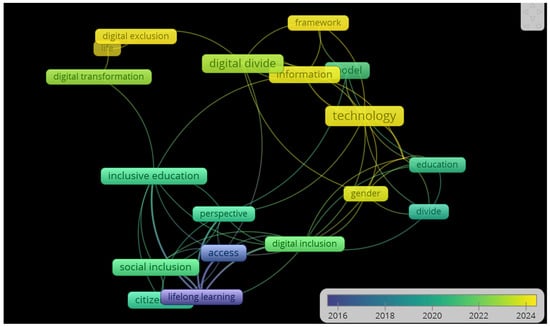
Figure 2.
Keyword co-occurrence WoS map based on average publication year.
Between 2020 and 2022, keywords such as “model”, “inclusive education”, and “social inclusion” gained prominence, reflecting research focused on social inclusion models through digital education in various contexts, including rural areas, urban settings, and vulnerable populations.
From 2022 onward, keywords such as “digital exclusion”, “digital divide”, “technology”, “framework”, and “information” began to emerge, signaling a continued effort to explore pathways for reducing digital exclusion and increasing the effective use of information and technology.
An analysis of keyword co-occurrence in Scopus (Figure 3) revealed that during the early part of 2022 (second half of the year), prominent terms included “social inclusion”, “inclusion”, “sustainable development goal”, “teaching”, and “COVID-19”. These keywords reflect the impact of the COVID-19 pandemic and the forced digitalization that occurred during periods of social isolation, which emphasized the urgent need for new models of teaching and learning.
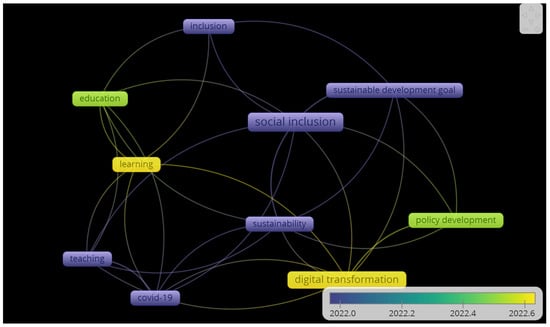
Figure 3.
Keyword co-occurrence Scopus map based on average publication year.
Another important aspect highlighted by these keywords is the influence of the 2030 Agenda and its goals related to development and inclusion.
In the second and third stages of 2022 (2022.2 and 2022.4), keywords such as “education” and “policy development” emerged, highlighting the role of public policies in advancing inclusive digital education.
Finally, terms such as “learning” and “digital transformation” reflect studies addressing the need for new learning models to support digital transformation—serving as a foundation for improving people’s quality of life and enabling the development of smart cities.
Based on the contributions identified in both databases, a timeline is outlined in Figure 4, with each key milestone exemplified by the most relevant article according to the associated keywords.
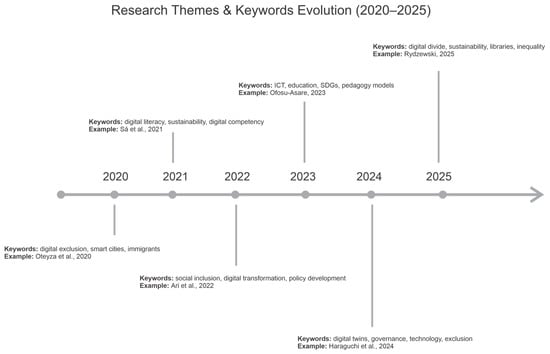
Figure 4.
Timeline of research themes and keyword evolution (2020–2025) [1,14,29,30,31,32].
Thus, it is evident that the topic is addressed in both databases following a similar trajectory, reinforcing these themes as relevant and emerging lines of research. In Figure 5, the evolution of publications in WoS and Scopus can be observed.
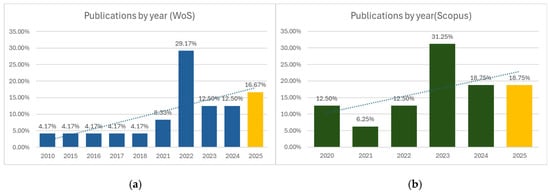
Figure 5.
Percentage distribution of publications per year in the analyzed databases: (a) Publications by year in WoS and (b) publications by year in Scopus.
The WoS database contains earlier records, beginning in 2010, followed by a five-year gap without publications. In contrast, the Scopus database presents its first record only in 2020, with a steady flow of publications from that point onward. Both databases show a growth trend, as evidenced by the trend line in the graphs, and recorded an increase in publications following the COVID-19 pandemic. In 2021, this impact is evident through the articles by [33] in WoS and [32] in Scopus. The final columns, highlighted in yellow, indicate that the year 2025 is still ongoing, signaling that the data for this period are not yet complete. Both studies highlight how the COVID-19 pandemic exacerbated digital inequalities in education. The authors of ref. [33] discuss strategies to promote digital equity, while the authors of [32] emphasize the importance of developing digital competencies to foster a more sustainable society. When analyzing the publication peaks in each database, we observe that WoS reached its highest point in 2022, with 29.17% of the total sample (seven articles). During this year, several articles focused on specific groups, such as NEET youth (not in employment, education, or training) and students in special education settings—children with disabilities served by specialized schools and rehabilitation centers [34].
In Scopus, the peak year was 2023, accounting for 31.25% of total publications (5 articles). That year’s publications emphasized developing models to integrate digital education while ensuring sustainability [17,26], teacher training for inclusive and sustainable education [35], and institutional readiness for inclusive digital accessibility [36]. The most cited articles from each year are highlighted in Table 2.

Table 2.
Most cited articles were identified in the Scopus and WoS databases sample.
It can be observed that the most cited article in Scopus is a literature review, while the most cited article in WoS is a reflective piece prompted by the COVID-19 pandemic, which revealed the need to rethink education. Three out of the five most cited articles are indexed in both databases. No author in both databases stood out regarding publication volume or article count.
Among the countries with the highest number of publications in WoS are Italy (16.67% of the articles), Poland (16.67%), Spain (12.50%), and the United States (12.50%). Brazil (8.33%) shares fifth position with Australia and Portugal regarding research on this topic (Figure 6).
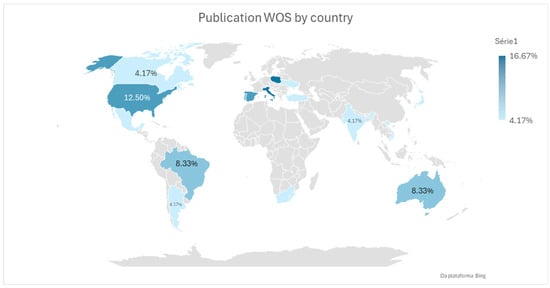
Figure 6.
Geographical distribution of publications indexed in WoS, by authors’ country of affiliation.
The countries with the most publications demonstrate concern regarding the digital divide, particularly regarding age, geographic location (rural vs. urban), social strata, and access to public policies. A common thread among these studies is the focus on vulnerable populations—such as older adults, students, people with disabilities, and those living in peripheral regions. All of these factors are directly related to key challenges for sustainability. Brazilian articles, in particular, focus on the sustainability of education within the framework of the SDGs.
In Scopus (Figure 7), the countries with the most publications were Spain (25%), followed by South Africa (18.75%). Brazil (12.50%) ranked third, alongside countries such as Portugal and Australia.
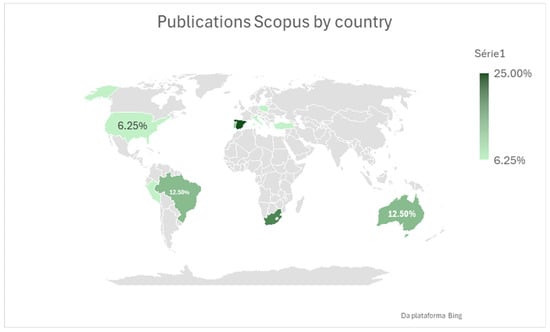
Figure 7.
Geographical distribution of publications indexed in Scopus’ country of affiliation.
The publishing pattern among the top-contributing countries in Scopus mirrors that of WoS, with a strong focus on inclusion and the role of digital technologies. There is also explicit reference to the SDGs. Most studies frame formal and informal education as a key driver for reducing inequalities, fostering innovation, and promoting digital citizenship. The Brazilian articles indexed in Scopus are the same as those indexed in WoS.
Regarding disciplinary focus (Figure 8), the area with the most publications in WoS was Environmental Sciences Ecology (29.17%). This predominance is due to the topics addressed in the articles, such as sustainability, digital exclusion, and regional development, often emphasizing social and environmental justice.
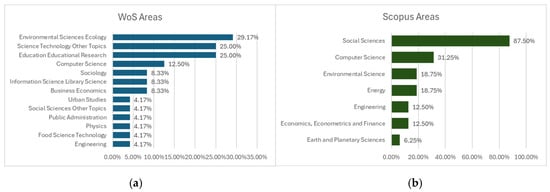
Figure 8.
Percentage distribution of knowledge areas in the analyzed publications: (a) Subject areas of articles in the WoS database and (b) subject areas of articles in the Scopus database.
WoS classifies these interdisciplinary themes under “environmental sciences” because they explore the impact of technology and exclusion on communities and human ecosystems.
The second most prominent category was Science Technology Other Topics (25.00%), which included articles discussing the role of digital technologies, digital twins, artificial intelligence, libraries, and smart cities.
As not all of these topics fall strictly under computer science, WoS classifies them under other topics in science and technology.
In third place was Education Educational Research (25.00%), comprising various studies on digital literacy, inclusion in educational environments, inequalities in access to information, and pedagogical approaches using Information and Communication Technologies (ICTs).
These findings reflect a strong interdisciplinary concern with digital inclusion, sustainability, and social transformation through technology. The classification of these studies across distinct fields suggests a transversal research approach emphasizing technology’s social and environmental impacts. There is also a growing interest in digital education, libraries as social agents, and technological governance.
In Scopus, the field with the most publications was Social Sciences. This category includes studies on inclusive education, digital transformation, public policies, sustainability, and technology for social cohesion—all themes traditionally grounded in the social sciences.
Even when the articles address technology or environmental concerns, the underlying focus remains on human and social impact, including older adults, digital accessibility, and digital literacy for vulnerable populations. A strong influence of the SDGs was also observed, with particular attention to SDG 4 (Quality Education and Sustainability) and SDG 11 (Sustainable and Inclusive Cities).
The second most prominent category was Computer Science, accounting for 31.25% of the publications. This field encompasses ICTs in basic education, inclusion through digital accessibility, and libraries and artificial intelligence as infrastructures for inclusion.
It is worth noting that WoS includes a broader range of subject areas than Scopus, allowing for greater specificity. If Scopus had a more granular classification of Social Sciences and Computer Science through subfields, the categorizations would likely be more aligned.
Among the journals publishing most frequently on the topic, Sustainability stood out as the leading outlet, accounting for 20% of the articles in WoS and 12.5% in Scopus (Figure 9). In both databases, Sustainability published at least twice as many articles as the second-ranking journal, reaffirming its commitment to sustainability-related themes.

Figure 9.
Distribution of articles by journal in the analyzed databases: (a) Distribution of publications by journal in the WoS database and (b) distribution of publications by journal in the Scopus database.
A comparison of publication sources across the databases reveals that Scopus offers broader coverage and includes more journals from emerging countries and specific regions, such as Africa and Latin America. This results in greater geographic diversity, although not necessarily a higher impact. On the other hand, the WoS generally applies more rigorous indexing criteria and is traditionally regarded as a more selective database. Journals indexed in WoS tend to have a higher global impact—such as Technological Forecasting and Social Change.
It can be observed that some journals published the same number of articles. We chose to retain all of them to ensure an accurate cutoff point, as including only one or two would omit the names of other journals with equal output, thereby complicating the prioritization process.
Indexed in both databases, the journal Sustainability is highly representative and multidisciplinary. Its prominent position in both datasets underscores its relevance as a key platform for sustainable development and social innovation research.
3.3. Step 3—Detailing, Modeling, and Evidence-Based Validation
Bibliometric analysis (co-citation and bibliographic coupling) identified research approaches and fronts by mapping author relationships and thematic structures, revealing knowledge evolution and trends [27]. Unlike the typical merging of the WoS and Scopus databases, this research kept them separate due to its unique, three-keyword intersection.
WoS co-citation analysis revealed two main clusters (Figure 10). The “Digital Access” cluster comprises foundational work by Van Dijk et al. [18,19], who proposed a four-level access model (motivational, material, skills-based, and usage-related), challenging the reductionist view of the digital divide as merely physical access. Ref. [6] extends this by exploring gender-based digital exclusion, emphasizing cultural and social influences on women’s technology use, drawing on Van Dijk’s framework. The authors of ref. [39] further contribute a methodological framework for measuring digital skills beyond physical access, highlighting socioeconomic and social support impacts. This cluster underscores that digital exclusion is a multifaceted issue, encompassing socioeconomic, educational, and cultural dimensions. The “Digital Skills” cluster prominently features works by [19,40]. The authors of ref. [40] systematized the literature on digital skills, usage, and outcomes, noting a growing focus on the “third level” of the digital divide: the actual benefits of Internet use. Similarly, ref. [19] identified this shift from mere physical access to digital skills and meaningful technology use while critiquing the conceptual ambiguity of the “digital divide.” Both studies in this cluster highlight inequalities in digital usage outcomes, the necessity of digital competencies, and the importance of understanding who truly benefits from Internet access, sharing a concern for the conceptual and methodological robustness of studies in this field.
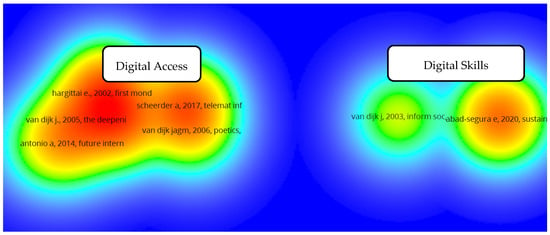
Figure 10.
Author co-citation density map from the WoS database, highlighting thematic clusters with higher influence in the analyzed literature.
Scopus co-citation analysis (Figure 11) revealed four key independent studies. The authors of ref. [25] present the Internet as essential for human rights. The authors of ref. [41] explore digitalization’s role in citizen participation in urban planning. The authors of ref. [42] analyze the impact of COVID-19 on corporate digitalization. Finally, the authors of ref. [23] provide foundational methodology for content analysis, especially for large textual datasets. Thus, Refs. [25,41] are categorized under “Digital Access”, focusing on inclusion and democratic participation. Ref. [42] highlights digitalization’s organizational and educational impacts, while ref. [23] is grouped under “Methods”, providing analytical foundations for studying these phenomena.
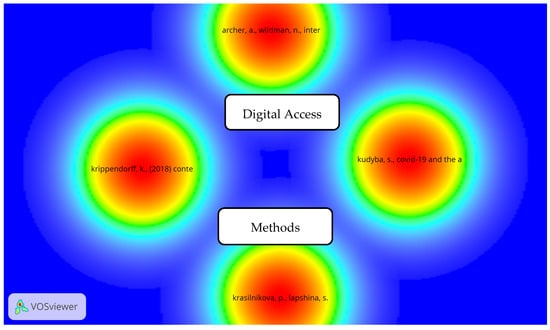
Figure 11.
Author co-citation density map from the Scopus database, highlighting thematic clusters with higher influence in the analyzed literature.
WoS coupling analysis (Figure 12) identified five research fronts, reflecting contemporary debates on digitalization, sustainability, inclusion, and education. The first front, “Digital Exclusion, Aging, and Social Inclusion”, spearheaded by [24], examines the Digital Grey Divide, linking aging and digital technology use to social inclusion and connects with [1]’s work on digital inequalities undermining sustainable development for vulnerable populations. The second, “Teachers and Digitalization”, represented by [31], focuses on integrating ICT into teaching in low-resource contexts, advocating for digitalized education adapted to rural African realities. The third front, “Institutional Infrastructure and Public Policies”, is the most prominent. Led by [36], it introduces the MARSAD tool for assessing public institutions’ digital readiness, emphasizing accessibility for individuals with disabilities and aligning with SDG 11. This cluster complements debates by proposing evaluation frameworks for inclusive digital policies. The fourth front, “Digital Capital”, includes [8] and examines how the digital divide influences digital capital formation, mediated by factors such as age, gender, education, and location, advocating for inclusive policies to address SDGs 4, 9, and 10. Finally, the fifth front, “Digital Inequality”, led by [1], explores multidimensional digital inequality, from access to skills and benefits, and its impact on sustainable development, education, and social equity. These five research fronts collectively underscore the need for integrated, cross-sectoral approaches to ensure socially just, inclusive, and sustainable digital transformation. Far from operating in isolation, these thematic clusters exhibit intricate interdependencies that significantly shape the landscape of digital education and societal inclusion. For instance, the pervasive challenges of “Digital Inequality” are demonstrably compounded by phenomena explored within “Digital Exclusion, Aging, and Inclusion”, where demographic vulnerabilities exacerbate existing digital divides. Effectively mitigating these disparities demands robust “Institutional Infrastructure and Public Policies” that not only expand access but also cultivate “Digital Capital”, transforming mere connectivity into a tangible resource for individual and collective advancement. Moreover, the effectiveness of initiatives focused on “Teachers and Digitalization” is intrinsically linked to the presence of supportive policy frameworks and adequate institutional capacities, ensuring that pedagogical innovations can be equitably implemented and sustained. Ultimately, understanding these dynamic interrelationships is paramount for developing comprehensive strategies that leverage the transformative potential of digitalization to foster genuinely equitable and sustainable development, in direct alignment with global agendas such as the United Nations Sustainable Development Goals.
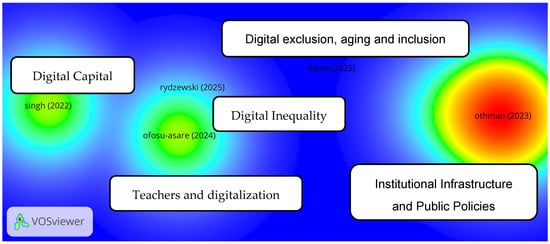
Figure 12.
Density map of bibliographic coupling among articles from the WoS database, highlighting those with greater bibliographic similarity.
Scopus coupling analysis (Figure 13) identified five clusters, revealing an interdisciplinary research front focused on achieving an inclusive and sustainable society through digital transformation by integrating public policies, educational practices, and management models.
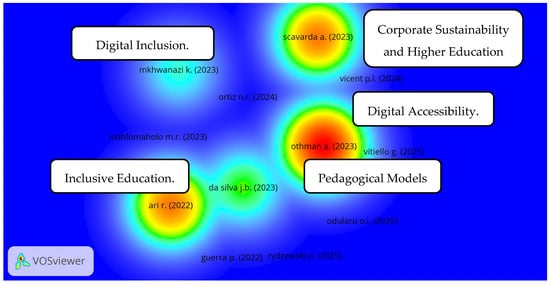
Figure 13.
Density map of bibliographic coupling among articles from the Scopus database, highlighting those with greater bibliographic similarity.
The first cluster, “Inclusive Education”, led by [14], examines the role of stakeholders—school leaders, teachers, and governments—in promoting inclusive education amidst digital transformation, highlighting persistent gaps in training and funding. The second cluster, “Pedagogical Models”, represented by [26], proposes an innovative pedagogical model that integrates ICT and the SDGs for socially vulnerable students, emphasizing interdisciplinary practices aligned with the 2030 Agenda. These two clusters mutually reinforce each other by addressing both the importance of inclusive education and offering practical models for its implementation.
The third cluster, “Corporate Sustainability and Higher Education”, includes [17], which maps sustainability practices in higher education institutions and links digitalization with university governance and inclusion. The fourth cluster, “Digital Accessibility”, features [36] (also seen in the WoS coupling analysis), assessing institutions’ digital readiness to promote inclusion and accessibility for people with disabilities. Finally, the fifth cluster, “Digital Inclusion”, led by [43], demonstrates how digital maturity influences educational institutions’ crisis response, introducing the concept of digital resilience and its relationship with social exclusion.
Collectively, these studies, though diverse in scope and methodology, converge on creating an educational landscape built on equity, social inclusion, and a firm commitment to the SDGs. They offer both diagnoses and concrete solutions, strengthening educational and technological policies with high social impact. Furthermore, other relevant studies, anchored in the UN 2030 Agenda and SDGs, consistently address social inclusion, sustainability, and educational/technological innovation. They tackle the need for more equitable and accessible environments for various vulnerable populations—including people with disabilities [20], at-risk youth [34], early childhood learners [35], local communities [15], older adults [13], and economically marginalized groups in Peru [44]. The proposed strategies, ranging from universal design and transmedia storytelling to strengthening institutions, underscore the transformative power of education and technology in reducing inequalities and fostering a more inclusive and resilient society.
Table 3 was developed to directly link bibliometric coupling clusters with SDGs, deepening the analysis. This systematization clarifies the scientific literature’s contribution to the 2030 Agenda, especially SDGs 4, 9, 10, and 11, which consistently appear across most thematic clusters.

Table 3.
Thematic clusters and associated SDGs.
Inter-rater reliability was assessed by two researchers via independent in-depth reading, using the Kappa coefficient (Equation (1)). This coefficient, used by [45,46], accounts for agreement beyond chance, based on observed agreement (Co, percentage of studies mutually included or excluded) and chance agreement (Ca). The analysis yielded an observed agreement of 96.4% and a chance agreement of 71.7%, resulting in a Kappa coefficient of 87.39%, considered excellent per [47] guidelines (Table 4). This assessment led to the selection of 21 articles, as presented in Table 5.

Table 4.
Agreement matrix between researchers for Kappa coefficient calculation.

Table 5.
Systematic review articles: Methods, sample, implications, and SDGs.
4. Proposed Integrative Model
Based on the selected documents and a thorough reading by the authors, an integrative model (Figure 14) was developed to consolidate the contributions of the main studies on the topic and provide greater linearity to the body of knowledge.
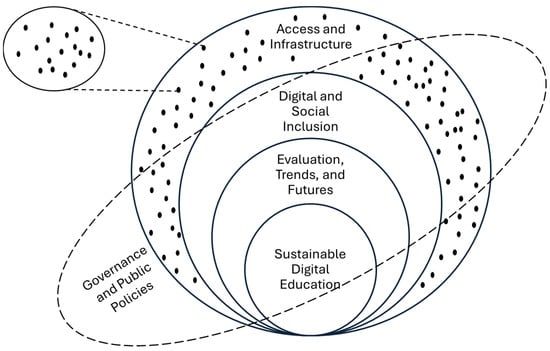
Figure 14.
Integrative model of thematic axes.
The integrative model was conceived as a sphere representing the sustainability of the process and the different stages at which each region, country, or organization may find itself in the context of sustainable digital social inclusion through education.
The sphere is structured in layers, reflecting the complexity of the digitalization process. The outermost layer is titled Access and Infrastructure. This group encompasses the technical and structural foundations that make digital transformation possible. It maintains a direct flow with inclusion, education, and public policy axes. Studies emphasize the importance of connectivity, stability, and quality [25], and the access limitations present in regions marked by structural inequalities [6]. This layer functions as a prerequisite for all others. It is important to highlight that this layer is fragmented into various nodes, each representing different stakeholders that shape infrastructure—government, private sector, and civil society—since current technologies cannot function effectively when dependent on a single actor.
The next layer is Digital and Social Inclusion. This includes scholars such as those authors of [25], who advocate for Internet access to be treated as a fundamental social right, especially in an era of pervasive digitalization. Also included are the authros of [6], who discuss how gender issues and sociocultural barriers prevent women in developing countries from accessing technology. In this layer, we observe “invisible barriers” tied to deep-rooted societal inequalities such as gender, race, income, age, and migration status. In other words, even when infrastructure is available, it is essential to overcome social barriers.
This group is directly linked to Sustainable Digital Education (through access and equity) and to Evaluation, Trends, and Futures, since it is through inclusion that the real impact of public policies can be assessed.
We encounter the layer Evaluation, Trends, and Futures deeper into the sphere. This stage opens the discussion on the need for continuous measurement and monitoring. It encompasses studies identifying global trends, using United Nations indicators (SDGs), and the role of digital systems in promoting equity [9]. Related authors reinforce the importance of impact assessment and alignment of actions with global targets. This layer serves as the reflective axis of the system—evaluation enables understanding of what works and guides course correction in inclusion, education, access, and policy efforts.
At the core of the sphere lies Sustainable Digital Education, the central nucleus of the framework. It is nourished by infrastructure and inclusion and, in turn, informs the evaluation of public policies and the demand for governance. Within this core, ref. [14] highlights how educational policies and practices must be adapted to the realities of sustainability and inclusion, primarily through teacher training. Additionally, ref. [20] offers a historical perspective on the evolution of inclusive education, focusing on accessible and adaptive educational technologies.
A key feature of the model is the presence of a transversal axis: Governance and Public Policies. This backbone intersects all layers as it structures and ensures the viability and continuity of initiatives in inclusion, education, and access. The authors of ref. [14] explain how policies must be accompanied by training and resources, particularly in the case of inclusive education. Ref. [9] demonstrate the relationship between policy, funding, and social impact through a bibliometric analysis of sustainable digital transformation.
The proposed integrative model’s direct applicability in public policy formulation and educational planning stands out. By structuring the intersection of digitalization, social inclusion, sustainability, and education into interdependent layers, the model offers a systemic framework adaptable to various institutional and geographic contexts. Policymakers may employ the model as a diagnostic and monitoring tool to address digital inequalities, aligning actions with the Agenda 2030 goals [16].
Educators and school administrators may use it as a foundation for designing pedagogical strategies, training programs, and digital inclusion projects rooted in empirical evidence. Furthermore, the transversal axis of governance and public policy ensures integration across dimensions, supporting more informed, coordinated, and sustainable decision-making. Thus, the model synthesizes the existing scientific literature and serves as a practical tool for translating knowledge into effective social action.
Consequently, the findings of this review reinforce the urgent need for public policies and educational practices that align digital transformation with sustainability principles. Promoting accessible digital environments, coupled with teacher training and adequate infrastructure, can catalyze positive impacts on multiple fronts: reduction in physical resource usage, broader democratization of knowledge, and the advancement of the knowledge economy. In this sense, sustainability emerges as a transversal guiding principle, articulating inclusion, innovation, and governance.
5. Discussion
Digital transformation, sustainability, and social inclusion are increasingly intertwined challenges in contemporary education systems. As societies demand more equitable access to technology and sustainable practices, education emerges as a key driver for inclusive and lasting change. Responding to this need, this systematic review maps and organizes the scientific literature at the intersection of these domains. Our analysis highlights education’s strategic role in promoting digital and social inclusion, positioning it as a central mechanism to reduce structural inequalities and strengthen digital citizenship. The findings consistently show that technological infrastructure alone is not sufficient; instead, sustainable and inclusive digitalization requires careful attention to social, cultural, and pedagogical dimensions.
The consolidated body of knowledge revealed multiple interconnected research fronts. These include the digital inclusion of older adults, teacher training in low-connectivity environments, the formulation of public policies for digital accessibility, the role of digital capital as an equity factor, and a critical, multidimensional analysis of digital inequalities. These themes underscore that contemporary challenges demand interdisciplinary approaches that integrate educational practices, institutional policies, and technological innovations. Our research questions regarding the main contributions of the scientific literature, leading authors, primary research fronts, and the organization of information were fully addressed through the application of the TEMAC method, keyword analysis, and the development of our integrative model.
Our proposed integrative model offers a relevant conceptual contribution by synthesizing selected articles into structured axes, represented as concentric spheres. These layers include “Access and Infrastructure”, “Digital and Social Inclusion”, and “Evaluation and Trends”, with “Sustainable Digital Education” at the core. A transversal “Governance and Public Policies” axis connects all dimensions, reinforcing that effective actions depend on intersectoral coordination and impact indicators. This model provides a systemic, applicable, and adaptable vision for diverse educational and geographical contexts.
To elaborate on cross-sector collaboration, our policy recommendations specify the distinct roles of governments, educational institutions, and enterprises. Drawing from the recent literature on green fuel development [48,49] and sustainability in higher education [50], a clear framework emerges. These sources consistently advocate for robust cooperation—between industry, academia, and government—to drive innovation and close knowledge gaps. Governments are crucial for promoting sustainability through comprehensive policies, regulatory frameworks, and dynamic financial incentives [49,50]. They must also foster international cooperation and ensure that policy development involves diverse stakeholders [48,49,50]. Enterprises are essential for reducing emissions through alternative fuels and require policymaker support for green transformation. They can leverage policy information to guide green upskilling and recruitment, collaborating with higher education for cutting-edge resources [48,50]. Educational institutions, particularly in higher education, are vital for developing new, sustainability-focused growth models. They must update curricula to include key sustainability skills, align pedagogical approaches with competencies, and incorporate SDGs and the 2030 Agenda [50]. Partnering with industry is key for practical learning experiences [48,50].
As mentioned in the introduction, there is a clear lack of systematic reviews that combine digital transformation, sustainability, social inclusion, and education in a unified way. This gap is evident in the ongoing absence of strategic vision [51] and the limited analysis of the real impact of digital transformation in education, which often focuses only on introducing new technologies [51,52]. Additionally, there is little attention to policy frameworks and governance structures that support digital inclusion [51,53], and the social and sustainability aspects of digital public services are often overlooked [53]. Although some reviews cover parts of these topics, such as sustainability in digital education [52] or digital inclusion in e-government [53], none fully integrate all four areas. This fragmentation is worsened by critiques of technology-focused approaches that ignore broader social and cultural contexts [51,53], as well as by organizational silos that limit the interdisciplinary collaboration needed for true transformation. To address these challenges, this study proposes an integrative framework designed to fill this gap. The model adopts a multidisciplinary perspective to connect digital transformation, sustainability, social inclusion, and education in a clear and strategic way. While further empirical research is needed to validate and improve the framework, it provides a useful foundation for creating more inclusive, context-aware, and sustainable digital strategies in education and related fields.
As a limitation of this study, our reliance on WoS and Scopus, while providing broad coverage and trusted information, may have slightly limited the total diversity and breadth of sources. Although these databases are comprehensive, some highly specialized or regional studies might not have been included. Additionally, the rapid evolution of digital technologies and sustainability means that even recent research can quickly become outdated. Nevertheless, employing these widely recognized databases enabled us to obtain a robust and reliable dataset for our analysis.
6. Conclusions
By mapping the scientific literature, this systematic review was able to successfully link education, social inclusion, and sustainable digital transformation. The importance of education in addressing structural inequalities and fostering digital citizenship is highlighted in our findings. We propose an integrated model that serves as a foundational framework for future research by synthesizing disparate concepts and providing a comprehensive understanding of this complex interplay. In the future, our recommendation is to expand data sources, adopt participatory methodologies that involve educators and school administrators, and deepen the empirical evaluation of public policies aimed at digital inclusion. To develop this field continuously, it is necessary to bridge research, practice, and public policy towards a truly inclusive and sustainable digital transformation.
Author Contributions
Conceptualization, A.M.M. and P.E.R.-C.; methodology, A.M.M. and M.R.S.; software, A.M.M.; validation, A.M.M., P.E.R.-C. and M.R.S.; formal analysis, P.E.R.-C.; investigation, P.E.R.-C.; resources, P.E.R.-C.; data curation, P.E.R.-C.; writing—original draft preparation, A.M.M. and M.R.S.; writing—review and editing, P.E.R.-C. and M.R.S.; visualization, A.M.M.; supervision, P.E.R.-C.; project administration, P.E.R.-C.; funding acquisition, P.E.R.-C. All authors have read and agreed to the published version of the manuscript.
Funding
This research received no external funding.
Institutional Review Board Statement
Not applicable.
Informed Consent Statement
Not applicable.
Data Availability Statement
The raw data supporting the conclusions of this article will be made available by the authors upon request.
Acknowledgments
Many thanks to the editors and all of the reviewers who provided constructive comments and suggestions, which helped to greatly improve the paper.
Conflicts of Interest
The authors declare no conflicts of interest.
Appendix A
Figure A1 shows a mind map of key concepts. This mind map provides a detailed visual representation of how Digital and Sustainable Education fundamentally intertwines with Social Inclusion, demonstrating a mutually reinforcing relationship vital for progress. It clearly articulates that Educational Digitalization, through its various means—such as the adoption of virtual learning environments and the widespread use of digital materials—serves as a primary driver. This digitalization actively contributes to Educational Sustainability by generating tangible benefits across multiple dimensions: it reduces environmental impact through decreased paper consumption, less physical travel, and a lessened demand for traditional physical infrastructure; it optimizes economic resources by fostering cost savings and enhancing overall efficiency; and critically, it directly advances the social dimension of sustainability by actively bridging digital gaps. These efforts ensure that Social Inclusion, the overarching goal of achieving equity and universal access to knowledge, is not just an aspiration but a direct outcome. The interconnectedness shown in the map highlights that these components work in concert, leading to the ultimate aim of Sustainable and Equitable Development, thereby aligning educational initiatives directly with crucial global targets like the SDGs (SDGs 4, 9, 10, 11, 12, etc.).
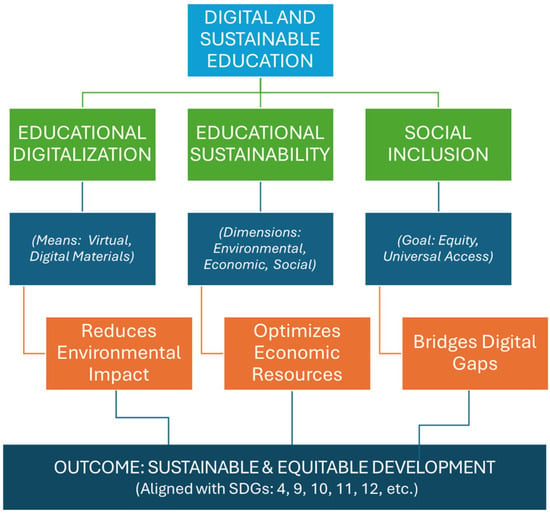
Figure A1.
Mind map of key concepts.
References
- Rydzewski, P. Digital Inequality and Sustainable Development. Probl. Ekorozwoju 2025, 20, 96–108. [Google Scholar] [CrossRef]
- Liu, Y.; Wang, H. Who on Earth Is Using Generative AI? World Bank: Washington, DC, USA, 2024. [Google Scholar]
- Acemoglu, D.; Restrepo, P. Tasks, Automation, and the Rise in U.S. Wage Inequality. Econometrica 2022, 90, 1973–2016. [Google Scholar] [CrossRef]
- Gmyrek, P.; Winkler, H.; Garganta, S. Buffer or Bottleneck? Employment Exposure to Generative AI and the Digital Divide in Latin America; World Bank: Washington, DC, USA, 2024; ISBN 9789220410028. [Google Scholar] [CrossRef]
- Elena-Bucea, A.; Cruz-Jesus, F.; Oliveira, T.; Coelho, P.S. Assessing the Role of Age, Education, Gender and Income on the Digital Divide: Evidence for the European Union. Inf. Syst. Front. 2021, 23, 1007–1021. [Google Scholar] [CrossRef]
- Antonio, A.; Tuffley, D. The Gender Digital Divide in Developing Countries. Futur. Internet 2014, 6, 673–687. [Google Scholar] [CrossRef]
- McCarthy, A.M.; Maor, D.; McConney, A.; Cavanaugh, C. Digital transformation in education: Critical components for leaders of system change. Soc. Sci. Humanit. Open 2023, 8, 100479. [Google Scholar] [CrossRef]
- Singh, S.; Singh, U.S.; Nermend, M. Sustainability in a Digitized Era Analyzing the Moderation Effect of Social Strata and Digital Capital Dependence on Digital Divide. Sustainability 2022, 14, 4508. [Google Scholar] [CrossRef]
- Abad-Segura, E.; González-Zamar, M.D.; Infante-Moro, J.C.; García, G.R. Sustainable management of digital transformation in higher education: Global research trends. Sustainability 2020, 12, 2107. [Google Scholar] [CrossRef]
- Singun, A.J. Unveiling the barriers to digital transformation in higher education institutions: A systematic literature review. Discov. Educ. 2025, 4, 37. [Google Scholar] [CrossRef]
- Ade, M.; Harahap, K.; Mahardhani, A.J. Strategies for Managing Information Technology Infrastructure to Improve Education Access in Remote Areas: A Comprehensive Approach to the Challenges and Solutions of Education Digitalization. Technol. Soc. Perspect. TACIT 2025, 3, 314–321. [Google Scholar]
- Sezen-Gültekin, G.; Argon, T. Barriers and Facilitators of Educational Sustainability: Metaphorical Perceptions and Views of Teachers. Int. J. Contemp. Educ. Res. 2022, 9, 279–281. [Google Scholar] [CrossRef]
- Vicent, P.L.; López, S.M.D.M.; Aroca, J.A.S. The SDGs and social inclusion of older adults: An educational innovation experience with ICT in higher education. Rev. Lusofona Educ. 2024, 61, 175–191. [Google Scholar] [CrossRef]
- Ari, R.; Altinay, Z.; Altinay, F.; Dagli, G.; Ari, E. Sustainable Management and Policies: The Roles of Stakeholders in the Practice of Inclusive Education in Digital Transformation. Electronics 2022, 11, 585. [Google Scholar] [CrossRef]
- Odularu, O.I.O. A review on the germaneness of libraries in sustaining information technology services: Rethinking towards futuristic strategies implementation. Libr. Manag. 2025, 46, 109–131. [Google Scholar] [CrossRef]
- United Nations. Transforming Our World: The 2030 Agenda for Sustainable Development; United Nations: New York, NY, USA, 2015. [Google Scholar]
- Scavarda, A.; Daú, G.; Scavarda, L.F.; Chhetri, P.; Jaska, P. A conceptual framework for the corporate sustainability higher education in Latin America. Int. J. Sustain. High. Educ. 2023, 24, 481–501. [Google Scholar] [CrossRef]
- Van Dijk, J.; Hacker, K. The Digital Divide as a Complex and Dynamic Phenomenon. Inf. Soc. 2003, 19, 315–326. [Google Scholar] [CrossRef]
- Van Dijk, J.A.G.M. Digital divide research, achievements and shortcomings. Poetics 2006, 34, 221–235. [Google Scholar] [CrossRef]
- Sánchez Blanco, L.; Lugones Hoya, A. Historical review of inclusive educational theories through digital archives. Eur. Public Soc. Innov. Rev. 2024, 9, 1–20. [Google Scholar] [CrossRef]
- Blewitt, J.; Gambles, B. The Library of Birmingham Project: Lifelong Learning for the Digital Age. J. Adult Contin. Educ. 2010, 16, 52–66. [Google Scholar] [CrossRef]
- Lambert, S.R. Do MOOCs contribute to student equity and social inclusion? A systematic review 2014–18. Comput. Educ. 2020, 145, 103693. [Google Scholar] [CrossRef]
- Krippendorff, K. Content Analysis: An Introduction to Its Methodology, 2nd ed.; SAGE Publications: London, UK, 2004; ISBN 0-7619-1544-3. [Google Scholar]
- Diana, M.G.; Mascia, M.L.; Tomczyk, Ł.; Penna, M.P. The Digital Divide and the Elderly: How Urban and Rural Realities Shape Well-Being and Social Inclusion in the Sardinian Context. Sustainability 2025, 17, 1718. [Google Scholar] [CrossRef]
- Archer, A.; Wildman, N. Internet access as an essential social good. In The New Common: How the COVID-19 Pandemic Is Transforming Society; Springer: Cham, Switzerland, 2021; pp. 29–33. [Google Scholar] [CrossRef]
- da Silva, J.B.; da Silva Frasseto, L.; Machado, L.R.; Bilessimo, S.M.S.; da Silva, I.N. A Pedagogical Model for Integrating Digital Technologies in Education: Workshops on Sustainable Development Goals (SDGS). J. Inf. Technol. Educ. Res. 2023, 22, 461–479. [Google Scholar] [CrossRef]
- Mariano, A.M.; Rocha, M.S. Revisão da Literatura: Apresentação de uma Abordagem Integradora. In Proceedings of the 2017 AEDEM International Conference—Economy, Business and Uncertainty: Ideas for a European and Mediterranean Industrial Policy, Reggio Calabria, Italy, 4–5 September 2017; pp. 427–443. [Google Scholar]
- Venkatesh, V.; Morris, M.G.; Davis, G.B.; Davis, F.D. User acceptance of information technology: Toward a unified view. MIS Q. 2003, 27, 425–478. [Google Scholar] [CrossRef]
- de Oteyza, M.O.G.; Sosa, M.J.; Lara, C.F. The integration of migrants in smart cities: The case of Madrid. Cuad. Geogr. 2020, 60, 244–262. [Google Scholar] [CrossRef]
- Haraguchi, M.; Funahashi, T.; Biljecki, F. Assessing governance implications of city digital twin technology: A maturity model approach. Technol. Forecast. Soc. Change 2024, 204, 123409. [Google Scholar] [CrossRef]
- Ofosu-Asare, Y. Developing classroom ICT teaching techniques, principles and practice for teachers in rural Ghana without access to computers or internet: A framework based on literature review. Int. J. Inf. Learn. Technol. 2024, 41, 262–279. [Google Scholar] [CrossRef]
- Sá, M.J.; Santos, A.I.; Serpa, S.; Ferreira, C.M. Digitainability—Digital Competences Post-COVID-19 for a Sustainable Society. Sustainability 2021, 13, 9564. [Google Scholar] [CrossRef]
- Pittman, J.; Severino, L.; DeCarlo-Tecce, M.J.; Kiosoglous, C. An action research case study: Digital equity and educational inclusion during an emergent COVID-19 divide. J. Multicult. Educ. 2020, 15, 68–84. [Google Scholar] [CrossRef]
- Guerra, P.; Sousa, S. Dreaming is not enough. Audiovisual methodologies, social inclusion, and new forms of youth biopolitical resistance. Front. Sociol. 2022, 7, 1020711. [Google Scholar] [CrossRef]
- Mahlomaholo, M.R.; Israel, H.; Mahlomaholo, S.M.G. Relationally Enhancing Teacher Education in Early Childhood Learning Environments Towards Sustainability. J. Curric. Stud. Res. 2023, 5, 56–68. [Google Scholar] [CrossRef]
- Othman, A.; Al Mutawaa, A.; Al Tamimi, A.; Al Mansouri, M. Assessing the Readiness of Government and Semi-Government Institutions in Qatar for Inclusive and Sustainable ICT Accessibility: Introducing the MARSAD Tool. Sustainability 2023, 15, 3853. [Google Scholar] [CrossRef]
- Cirulli, F.; Elia, G.; Lorenzo, G.; Margherita, A.; Solazzo, G. The use of MOOCs to support personalized learning: An application in the technology entrepreneurship field. Knowl. Manag. E-Learning 2016, 8, 109–123. [Google Scholar] [CrossRef]
- Marshall, B.L.; Dalmer, N.K.; Katz, S.; Loos, E.; Gómez, D.L.; Peine, A. Digitization of Aging-in-Place: An International Comparison of the Value-Framing of New Technologies. Societies 2022, 12, 35. [Google Scholar] [CrossRef]
- Hargittai, E. Beyond logs and surveys: In-depth measures of people’s web use skills. J. Am. Soc. Inf. Sci. Technol. 2002, 53, 1239–1244. [Google Scholar] [CrossRef]
- Scheerder, A.; van Deursen, A.; van Dijk, J. Determinants of Internet skills, uses and outcomes. A systematic review of the second- and third-level digital divide. Telemat. Inform. 2017, 34, 1607–1624. [Google Scholar] [CrossRef]
- Krasilnikova, P.; Lapshina, S. Digitalization of Citizen Participation in Urban Development Management. SHS Web Conf. 2021, 93, 05013. [Google Scholar] [CrossRef]
- Kudyba, S. COVID-19 and the Acceleration of Digital Transformation and the Future of Work. Inf. Syst. Manag. 2020, 37, 284–287. [Google Scholar] [CrossRef]
- Mkhwanazi, K.; Beharry-Ramra, A. Emerging Trends during the COVID-19 Pandemic: Digital. Afr. Renaiss. 2023, 1, 2023–2026. [Google Scholar]
- Ortiz, N.R.; Torres, J.V.; Rodríguez, V.H.P. Digital Financial Education for Economic and Financial Inclusion in Vulnerable Sectors of Peru. Theor. Pract. Res. Econ. Fields 2024, 15, 928–938. [Google Scholar] [CrossRef]
- Kitchenham, B.; Brereton, P. A systematic review of systematic review process research in software engineering. Inf. Softw. Technol. 2013, 55, 2049–2075. [Google Scholar] [CrossRef]
- Osborne O’Hagan, A.; Coleman, G.; O’Connor, R.V. Software Development Processes for Games: A Systematic Literature Review. In Communications in Computer and Information Science, Proceedings of the Systems, Software and Services Process Improvement (EuroSPI 2014), Luxembourg, 25–27 June 2014; Springer: Berlin/Heidelberg, Germany, 2014; Volume 425, pp. 182–193. [Google Scholar] [CrossRef]
- Landis, J.R.; Koch, G.G. The measurement of observer agreement for categorical data. Biometrics 1977, 33, 159–174. [Google Scholar] [CrossRef]
- Li, C.; Hao, Q.; Zhang, W.; Wang, S.; Yang, J. Development strategies for green hydrogen, green ammonia, and green methanol in transportation. Renew. Energy 2025, 246, 122904. [Google Scholar] [CrossRef]
- Zhang, W.; Li, C.; Jia, T.; Wang, S.; Hao, Q.; Yang, J. Evolutionary game analysis of sustainable aviation fuel promotion. Energy 2025, 322, 135723. [Google Scholar] [CrossRef]
- Spada, I.; Giordano, V.; Chiarello, F.; Martini, A.; Fantoni, G. Text mining on green policies for integrating sustainability in higher education. Int. J. Manag. Educ. 2025, 23, 101126. [Google Scholar] [CrossRef]
- Gkrimpizi, T.; Peristeras, V.; Magnisalis, I. Classification of Barriers to Digital Transformation in Higher Education Institutions: Systematic Literature Review. Educ. Sci. 2023, 13, 746. [Google Scholar] [CrossRef]
- García-Hernández, A.; García-Valcárcel Muñoz-Repiso, A.; Casillas-Martín, S.; Cabezas-González, M. Sustainability in Digital Education: A Systematic Review of Innovative Proposals. Educ. Sci. 2023, 13, 33. [Google Scholar] [CrossRef]
- Djatmiko, G.H.; Sinaga, O.; Pawirosumarto, S. Digital Transformation and Social Inclusion in Public Services: A Qualitative Analysis of E-Government Adoption for Marginalized Communities in Sustainable Governance. Sustainability 2025, 17, 2908. [Google Scholar] [CrossRef]
Disclaimer/Publisher’s Note: The statements, opinions and data contained in all publications are solely those of the individual author(s) and contributor(s) and not of MDPI and/or the editor(s). MDPI and/or the editor(s) disclaim responsibility for any injury to people or property resulting from any ideas, methods, instructions or products referred to in the content. |
© 2025 by the authors. Licensee MDPI, Basel, Switzerland. This article is an open access article distributed under the terms and conditions of the Creative Commons Attribution (CC BY) license (https://creativecommons.org/licenses/by/4.0/).